Can a Shrimp Punch Through Glass?
Are black holes really holes? Is there such thing as a genetic love match? Why do clouds move? For this month's science question and answer show, the Naked Scientists are joined by marine biologist Kate Feller, astrophysicist Matt Middleton, geneticist Patrick Short, and chemist Phillip Broadwith. Together they take on the science questions sent in by you...
In this episode

03:36 - Why do clouds move?
Why do clouds move?
One of the youngest listeners of The Naked Scientists put this question to Chris Smith and the panel. Chemist Phillip Broadwith and Physicist Matt Middleton floated upon an answer...
Phillip - I’d say Anya, there’s a little bit of both of those things happening. The spin of the Earth does have an effect, but the biggest effect is probably the wind. But the interesting thing is that the wind at high altitudes where the clouds are can be totally different to the wind at the surface where you’re standing, which is why you might sometimes see the clouds going one way and feel the wind blowing the other way.
Chris - Everything’s spinning in the universe, isn’t it Matt? Pretty much everything is spinning
Matt - Yeah. Angular momentum is everywhere. Look at the formation of the solar system from a big ball of gas and dust and it was rotating, and that’s why the planets now rotate.
Chris - That’s where I was going with that point that the Earth is turning, but why is the Earth turning as are the other planets in our solar system, it’s because they had spin to start with?
Matt - Absolutely. They’ve from a protoplanetary disc, so it was rotating and it was collapsing down and condensing and angular momentum is a conserved quantity. So the final product was also spinning because it couldn’t get rid of that energy, it couldn’t get rid of that rotation. Absolutely, this is why they’re spinning.
Chris - I was watching a stunning documentary on the channel BBC4 the other day about the Voyagers because it’s 40, it’s 40 years since the Voyager probes were launched. And one of the commentators on that programme pointed out that they’re making a 250 million year orbit of the galaxy, and when you think of it like that they're actually circuiting all the way round the galaxy, round the central black hole in our galaxy every 250 million years. I think it’s 250 million?
Matt - Something incredible number.
Chris - An incredible distance, isn’t it.
Matt - Yeah.
Chris - Thank you for that. Coming back to Anya’s question: the air is spinning therefore the air is moving, and the air is also moving in random directions because there’s additional air movements and input from the Sun.
Phillip - Yeah. The wind comes from - the Sun heats up the land, and over the water you get convection which is air heats up, it gets lighter, it moves up, but then you have to have more cold air coming in underneath to replace it. So that starts the whole thing moving and that’s where the wind comes from. But wind’s really important because it picks up moisture which is where the clouds come from. The whole atmospheric chemistry and physics of that system is important but also intriguing.
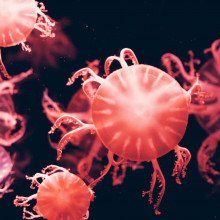
06:08 - Why is marine life so colourful?
Why is marine life so colourful?
Chris Smith asked Marine Biologist, Kate Feller, to dive into an answer for this question from Jack on Facebook. Astrophysicist, Matt Middleton, then explained how the planets get their colour.
Kate - This has a lot to do with the light environment underneath the water. In a coral reef system, which is probably most famous for being super colourful, the water is what we call ‘blue, blue blue, dead, dead, dead.’ It’s super clear and really blue and gorgeous and that’s why we like to go on vacation there. When you live in a clear water you can be really colourful and send lots of visual signals to your neighbours or to someone you want to mate with, and all that kind of stuff. But in lakes, in particular, and freshwater systems that are very closely tied to the land, you end up with a lot of dissolved organics. There’s a really great word for that, it’s called ‘gelbstoff’ that just means yellow guk or yellow stuff. So when you're in this darker, murkier, light absorbing water, you can’t send a signal as readily, so the fish tend to be a little bit browner.
Chris - They don’t bother?
Kate - It’s more like they evolve to fit in the environment that they live in.
Chris - If you’re not using bright colours, how do they find each other then?
Kate - A lot of chemical signals or sound vibrations and a lot of other sensory things. But with that, I must make you aware of the freshwater darter, which is one of the most beautiful, colourful types of fish I have ever seen in my life. They’re only found in the southeastern United States and the males of these species they just buck up to these rainbow, beautiful things in the spring with like red and green. They’re rainbow fish in these streams so that they can find the ladies.
Chris - Patrick?
Patrick - The colours are, obviously, great for attracting mates. Doesn’t it make them more likely to get attacked by a predator as well, or is there some sort of tradeoff or dance that they do?
Kate - You can use colourful signals as a sexual signal, which there’s risk with that, but if it didn’t work and they all got killed off then they wouldn’t survive. So obviously there’s some behavioural thing they’re doing to overcome the risk of being really flashy. But you can also become colourful to blend into your backgrounds, so if your background is really colourful then maybe you’ll be really flashy as well.
Chris - Lovely. One of the things that’s very colourful, given we have someone who’s a space scientist here, Matt, when we see pictures of our solar system depicted the planets are given colours. Is that accurate?
Matt - It can be. Some people like to fiddle with the colours of various things. If you’ve ever seen a picture of a Nebula, you do get red and blue from scattered light, but when you look at the planets what you're mostly seeing is either the rock - in the case of Mars which has a very thin atmosphere, you’re seeing the chemicals themselves in the atmosphere. Neptune and Uranus are the case in point - they’re very blue. Neptune is bluer than Uranus because it has a high content of methane. What happens is that that methane absorbs the red light coming from the Sun and it bounces back the blue, and this is why we see it.
Chris - So it’s not inaccurate; it’s not just artistic licence when we give planets colour. There is some genuine information coming back in the light from those planets which means we can say: “ah look, they must have a lot of chemical X in the atmosphere” and we give them that colour with reason?
Matt - Absolutely Chris. Absolutely.

09:14 - Can you make perfume from flowers?
Can you make perfume from flowers?
Chris Smith put this question from Lauren on Twitter to chemist, Phillip Broadwith, but it also captured the attention of astrophysicist, Matt Middleton, and marine biologist, Kate Feller.
Phillip - A lot of the chemicals in perfumes do actually come from flowers, particularly Damask roses and things like that, things that are very highly scented. But a commercial perfume will be a mixture of many, many ingredients, and the more expensive perfumes can have hundreds of ingredients. Some of those are fragrance molecules and there'll be some that are very light and they evaporate very easily, and they give you very floral scents.
And then there are some bigger, heavier ones that might stick around a bit longer and give you the more woody or earthy scents. They might even be really horrible if you got them in a high concentration, but in the small concentrations that you find in perfume they just add to that scent and that’s all part of it. Our sense of smell is insanely complicated and you’re not really smelling individual molecules, you’re smelling an ensemble effect of all the molecules in there.
The other thing that there is in a commercial perfume is that there are things that will either help the molecules to stick to your skin a bit more so that they’re released over time, or to stabilise it when it’s in the bottle so it doesn’t go off. If you make your own, which is perfectly possible, you can extract the scent compounds from the flower’s petals, which is where they’re most concentrated, using either hot water or sometimes oils, or coconut oil, something like that. It’s perfectly possible but what you’ll get a less complex scent and it probably will not last very long, because if you want to try and concentrate it you have to heat it, and then you can destroy some of the molecules where they’ll evaporate and that kind of thing.
Chris - So you might end up smelling but not the way you want to smell in the first place?
Phillip - Yeah. And, obviously, if you pick the wrong flowers there’s a potential hazard if you pick something that’s irritant or if you’re concentrating those things down. So you have to be a bit careful about what you pick but you can definitely do it, and there are recipes online that will give you more detailed instructions.
Chris - It could go wrong - be careful. Matt?
Matt - I’m basing this on an episode of Futurama, so can see where I source a lot of my information from. Isn’t there some horrible thing from a whale which is supposed to provide a base for some of these things - right?
Phillip - Yeah. It’s called “ambergris”. It’s basically whale vomit. It sometimes gets washed up on the beach and people find it and it’s worth a phenomenal amount of money. A couple of kilos and it might worth hundred of thousands of pounds.
Matt - We’re going to the beach now Chris - right?
Phillip - And it really stinks.
Chris - Have you found some?
Phillip - No. I’ve never found it but by all accounts if you get it in the pure form in that kind of concentrate, it really, really reeks. But in small amounts in the perfumes; it’s like musk from Yaks and stuff, they really reek if you get them concentrated.
Chris - Talking of things that whales issue, marine biologists are interested in whale ear wax as well, aren’t they? Because you get ear plugs of wax from certain whales that have rings in them deposited over time, a bit like tree rings. Do you know about this Kate?
Kate - I’ve not heard about this.
Chris - And it’s effectively locking away a chemical profile of what‘s going on in the whale over time. So if you find one of these ear plugs from a whale it may record the whale’s entire lifetime exposure to various things and what it’s hormones are doing at various times written into this plug of earwax.
Kate - That’s supercool. I wonder how much that’s worth?
Chris - It’s worth a fortune to the scientists who want to study it.
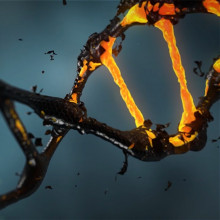
Can I change my DNA?
Chris put this question from Katie to Patrick Short, a geneticist from the University of Cambridge.
Patrick - Ten years ago the answer probably would have been absolutely not, but in the last five years or so there’s been an amazing revolution in genome editing technology. Just a month or two ago, the first FDA drug was approved to treat a pretty rare form of blood cancer. And the way that it works is actually by taking blood out of the patient, editing the DNA of the immune cells so that they would target the cancer specifically and then putting them back into the patient to target it.
There’s also other great examples like Muscular Dystrophy for instance. People have a genetic disease that causes their muscles to not develop properly, and there are therapies now that have already worked in animals and they’re starting to test them out on humans to actually go in and fix the mutation in the muscles, so it’s certainly possible.
Chris - Would you do this at the moment though because there’s been a lot of fanfare about the whole idea of going in and re-writing bits of DNA? But, in the examples you’ve given, one of them Chimera, the drug that Novartis have this year got licenced, that involves taking cells out of the body and changing them so that you know that when you put the cells back into the body you’ve got a reasonable degree of confidence that you’ve done something right and you’re not introducing something you shouldn’t. In the case of muscular dystrophy, the treatments there are a temporary, like sticking plaster, they’re not physically re-writing that person’s DNA are they?
But now we’ve got tools being developed in the laboratory, things like CRISPR, where people could physically go into your body and reprogramme the DNA in your cells which is I think a bit different than the two examples you’ve discussed.
Patrick - Yeah. I definitely wouldn’t try it at home and there are some people on the internet who will talk about biohacking and editing your own DNA . It’s certainly not safe and it probably doesn‘t do anything at this point.
Chris - Someone sent me a video to look at that she’s making a documentary. She may have released it now but was a chap who literally was doing this gene editing on himself, at home in California, and I was quite shocked to be honest. He was just injecting himself with this thing and there you go, “I am rewriting my DNA in my muscles”. It sounds terrifying dangerous?
Patrick - Yeah. And it think it’s pretty much snake oil. I think the most likely thing that’s going to happen to him is he’ll accidentally hurt himself. You have billions of cells in your body and you’ve got to go in, if you want to change the DNA in all of them, you’ve got to have some way to deliver this CRISPR enzyme to every cell in your body. I think the more likely thing is that we’ll actually start editing embryos, so families that want to make sure their child doesn’t have a severe disease will use this technology to go in an edit it when it’s just a couple of cells, and not when you’re already a full blown organism.
Chris - Phil?
Phillip - Presumably it’s much easier to do that when you’ve got a couple of cells to change and then it get’s carried through as the thing develops, right?
Patrick - Yeah, absolutely. It’s a little bit of a difficult subject to research because it’s ethically difficult to get access to live embryos. But there are some with severe genetic diseases that labs are working on to actually see if they can correct it so you might be able to have a successful pregnancy after correcting the Beta thalassemia of one of these diseases.
Chris - So just to summarise then: the bottom line is we can change DNA, people probably are changing DNA, and there are circumstances where it’s appropriate to do so. But, at this stage, it’s very early in the process, it’s probably a step too far because you may well do yourself harm, and it’s probably better not to do this except in the right circumstances, which is a reasonable summary.
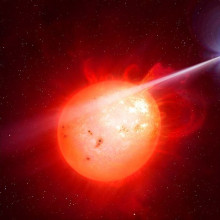
16:08 - Do three-star systems exist in space?
Do three-star systems exist in space?
This stellar suspicion was sent to The Naked Scientists from Caitlin. Chris Smith asked Astrophysicist, Matt Middleton, from the University of Southampton to give it a try. Starting with, what IS a trinary system?
Matt - Absolutely Chris, and Caitlin thank you for a lovely question. A binary system is where you have two stars that are orbiting around a common centre of mass. The way to think of that is imagine you’ve got a friend - let’s hope you all have a friend - and you hold their hands and you spin around. You are basically pivoting around that common thing. It’s not the greatest analogy but if you imagine that there are these two stars that are going round, orbiting around that common centre of mass.
Now, can you get trinary systems or higher order systems? Absolutely you can, absolutely. Most of the stars that we see, and if you look out on a clear night, they’re going to be binary systems. There are lots of individual, faint stars called red dwarfs, but we’re not going to be able to see those. But it turns out that loads, and loads, and loads of these are also trinary systems. In fact, you can also get quaternary, quinternary, etc, etc.
Chris - Just to get this right, you’re saying when I look at the stars in the sky, I’m seeing not one source of that light, but that’s actually a pair or maybe three, or even four little stars twiddling round each other?
Matt - Absolutely, and I’m going to blow your mind here. Probably the most famous star that we look at, the pole star, that’s a trinary system.
Chris - Oh goodness! Kate?
Kate - What’s the biggest system?
Matt - You can extend all the way to star clusters where we have thousands upon thousands upon thousands of stars who are all sort of interact in a gravitational way, so you can play that game endlessly. The problem is that the more you have, the more complicated those orbits become.
In a trinary system, what you quite often find is you’ve got a binary, so you’ve got your two friends zipping around, and then you’ve got another star that’s further round on a bigger orbit, and that’s nice and stable and nice and easy. But the more stars you chuck in there, it becomes quite complicated and quite a messy thing. What you’ll find is that there are a lot of trinaries, fewer with four stars, fewer with five, fewer with six, etc., etc., etc.
Chris - I just want to bring in Phil, but before I do, how do you know that this is the case, where we used to think it was just a star, now we’re calling in binary and trinary, and quaternary systems?
Matt - There’s this wonderful thing called the Hubble Space Telescope. Some of you may have heard of, I hope all of the listeners have, and it was able to resolve out these points of light. You can also look at how they move so you can get an idea from looking at the light itself that tells you about some of the motion. This is how you look for exoplanets and you can reveal ah, there must be another object in there somewhere.
Phillip - As an astrophysicist, if you’re looking at these kinds of trinary systems, does the mathematics get exponentially harder the more stars you start to involve?
Matt - That’s quite an understatement. There are these people who work on n-body simulations and those get extremely complicated. The most extreme version is where we have these simulations of the universe as it formed, so those are these incredible n-body simulations about dark matter, and gas, and supermassive black holes. So yeah, it gets ugly very, very quickly.
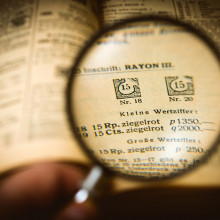
20:19 - Myth-busting: Are black holes really holes?
Myth-busting: Are black holes really holes?
with Matt Middleton - University of Southampton, Kate Feller - University of Cambridge, Patrick Short - University of Cambridge, Phillip Broadwith - Royal Society of Chemistry
Chris Smith asked our panel of experts to de-bunk some suspicious sounding science. Chris was joined by marine biologist, Kate Feller and geneticist, Patrick Short, from the Univeristy of Cambridge. Also in the studio was science journalist Phillip Broadwith from the Royal Society of Chemistry and Astrophysicist, Matt Middleton, from Southampton University.
Kate - A lot of times, like at museums or in toy stores, they’ll have these compound eye glasses so you could see like a fly, because flies don’t have eyes that are like ours, they’re made up of thousands of these little facets, and so theoretically you can put on these glasses and you can see like a fly. But that is totally wrong because the way that these glasses work is they multiply the image you’re seeing into just thousands of the same image over, and over, and over again and so it looks really crazy.
But really, a compound eye works where each facet focuses on a specific point in space and then they all get assembled like a pixel in an image. So they just have a lower resolution image of the world than say we do because our eyes are just different.
Chris - Don’t astronomers do a similar thing with telescopes, Matt, they have telescopes that have individual little facets that can then take a miniature snapshot of a part of space that they’re looking at and then they reassemble the whole thing into a big picture?
Matt - Essentially, what they’re doing there is they make these new reflecting dishes out of all these segments and they control those very, very carefully. So they’re not really looking at a single thing, they’re having to work together in unison to be able to focus on something, but the ability of these new instruments is absolutely phenomenal. You have all these little micro motions on these mirrors to create an absolutely stunning image, even if the weather is absolutely terrible.
Chris - You can manipulate each of the individual facets and you can adapt what they’re seeing to the conditions?
Matt - Absolutely. Adaptive optics, that’s what it’s called.
Chris - It says that your choice of myth is that black holes aren’t holes… I’m disappointed
Matt - Are you genuinely, Chris?
Chris - A little bit because we all like to think they’re some sort of giant vacuum cleaner in space that’s drawing everything in, but you’re saying that’s not true.
Matt - You can throw some repugnant people in there. The idea of black holes, the actual term is kind of anecdotal, but it was actually coined during a lecture. Before you talk about a black hole you also have to take a step back and remind yourself what a black hole actually is. Most people who do anything with astronomy will say: okay, it’s the end of a star’s lifetime. A massive star’s collapsed down and there’s no more forces to prevent that core collapsing so it’s going to go all the way down. It’s going to essentially go down to an infinitesimal point containing all the mass.
The reality is you can make a black hole out of anything. You can make a black hole out of a pen, you can make a black hole out of Chris, which I highly recommend. All you have to do is compress him down incredibly small so that he actually sits inside what we call the event horizon. When you go beyond the event horizon, not even light can escape from that body. So if you go near that event horizon, you won’t necessarily be torn apart - it depends on the size of the black hole, but you are going one way and one way only, and that’s towards the singularity. And that is a point which is so small, we don’t yet have an idea of how to describe it, we need something called quantum gravity.
There is one caveat, if the black hole is spinning you don’t get a singularity you have something called a ringularity. There’s these ideas that maybe we can manipulate those and create wormholes and then maybe Chris, you’ll finally have your hole.
Chris - But one thing that is often trotted out is that the centre of galaxies, like our Milky Way galaxy, there is a supermassive black hole and people say it’s about the size of Neptune or something or maybe a bit bigger out to the size of Neptune orbits, that kind of things. So it’s not literally a single point, there is something that’s quite large sitting there. It has physical dimension.
Matt - What people normally talk about is the size of the event horizon. We consider that to be the surface when in reality it isn’t. The definition starts blurring when we talk about black holes but that’s what we normally discuss, we talk about the size of the event horizon.
What’s remarkable is that galaxies and the supermassive black holes grew together, so something which is so small interacted with something which is billions and billions of times bigger. I think that’s amazing, so it tells you that galaxies and the black hole had to know about each other, and that is phenomenal.
Chris - Warps your mind as well as space time, doesn’t it?
Matt - A little bit.
Chris - Patrick; what’s your choice of myth?
Patrick - Everybody knows about the risk of older mothers having children, but I think the thing that’s not talked about enough is the risk of older fathers. I think we have all these - about egg freezing - we have all these societal norms that tacitly punish women for having children when they’re older. But actually, the father’s sperm is constantly multiplying, and every time it multiplies it makes mistakes and introduces mutations and so the older a father becomes, the more likely they are to have children with problems as well.
Chris - Well the Rolling Stones are doing all right, aren’t they, with the combined age between them of 7 trillion years or so? I can’t remember what it is now but they’re all pretty ancient; they’re doing okay.
Patrick - They’re not doing too bad. It’s about twice the risk or something from age 20 to 40 for men and then it starts getting worse and worse after that, but it’s just a role of the dice every time.
Chris - Matt, don’t get us done for libel…
Matt - Right. Remember that Mick Jagger’s trousers are so tight I don’t think he’s got any sperm left.
Chris - I think we’d better phone our lawyer. Kate?
Kate - Do they just negate the effects of being old men by having children with younger women?
Patrick - Yeah, that’s a really good point actually. It takes two to tango so maybe that’s the Rolling Stone’s secret.
Kate - So maybe that’s what women should be doing?
Patrick - Finding themselves a nice 25 year old man… yeah.
Chris - Let’s talk about chemistry. Phillip?
Phillip - My choice of myth is that chemicals that are made by plants and animals are somehow different to exactly the same chemicals if they’re made in a lab. If you’re talking about an absolutely pure substance there is absolutely no difference between the two. If you’re talking about having a real life thing it’s very difficult to get very pure things.
So if you were thinking about a chemical that you’ve isolated from a plant or an animal versus one that you’ve synthesised in a lab and not purified very well, then there would be differences between them because there’d be differences in the impurities in those things. But the actual chemicals themselves… no difference at all.
Chris - So when we talk about something being ‘natural,’ actually it’s just stuffed full of other stuff that we didn’t know was in there, or we can’t control the provenance of that? But something that comes out of a lab you actually have a better chance really of controlling the provenance. In fact, I’d rather have the lab version.
Phillip - Yeah, potentially. And that’s the other flip side of that is that people have this perception that a natural chemical is somehow better for you than one from a lab, but strychnine is a natural chemical.
Chris - So is cyanide, yeah.
Phillip - All of the poisons are natural things. That’s also another myth.
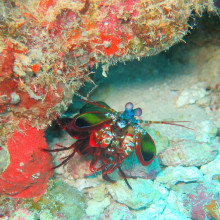
27:02 - Can shrimps punch through glass?
Can shrimps punch through glass?
Chris Smith put this punchy question from Sam, on Facebook, to Cambridge University marine biologist, Kate Feller...
Kate - I’ve heard this one a lot, and I have it on good authority from people who say they’ve experienced that this is possible. I personally have not experienced this in the decade I’ve been working with mantis shrimp. However, one time a colleague mailed us some rather large mantis shrimps, so we’re talking 10 to 20 cms in length, so big guys. They shipped them in some food tupperware containers inside two…
Chris - Were they for dinner then?
Kate - No, no, they were for science. It’s just easy to get them in and keep the water in. So they put them in these tupperware containers and then they put those in double bagged to make sure the water stayed inside and they’d make it safely to Baltimore from California. When they arrived all of the tupperware containers were just shattered because mantis shrimp were really angry to be shipped across the United States.
Chris - They didn’t like the east coast. They thought California was better.
Kate - Definitely west coast.
Chris - How did they do the damage?
Kate - Every mantis shrimp is able to fire this appendage that’s spring loaded; it’s called their raptorial appendage. They can either punch stuff with it or they can stab.
Chris - That’s one of their pincers is it?
Kate - No, it’s actually a modified part of their mouth. It’s a specialised pair of mouthparts and so these guys, I’m pretty sure, were punching holes by spearing, by opening it up and just stabbing the plastic. But there are species that are more specialised for the punching and all these bowling ball elbows that they’ll just smash things with. If you have a big enough one of those and you put it in an aquarium that maybe is not the thickest glass and they’re angry, they could probably put a crack in it.
Chris - So, note to marine biologists out there: when shipping your mantis shrimps, don’t use tupperware! Maybe use some other instrument instead...

Let's get Quizzical!
with Kate Feller - University of Cambridge, Matt Middleton - Southampton University, Patrick Short - University of Cambridge, Phillip Broadwith - Royal Society of Chemistry
As always, Chris Smith had a quiz for our panel of experts, they are: marine biologist - Kate Feller, chemist - Phillip Broadwith, astrophysicist - Matt Middleton, and geneticist - Patrick Short.
Chris - Team ONE will be Matt and Patrick. So Team TWO is Kate and Phillip.
ROUND #1 - Science Fact v Science Fiction
TEAM ONE - Matt and Patrick
QUIZ Q1: A hummingbird flaps its wings 150 times per second. True or false?
Matt - That’s got to be true hasn’t it? Either that or it’s an underestimate. I’ve seen videos - they really go for it!
Chris - So you’re going for true.
Matt - I think we’re going for true.
Chris: FALSE - Most hummingbirds flap at about 50 wingbeats per second. The fastest flapping recorded was 80 times per second by an Amethyst Woodstar Hummingbird. So you’re a little bit quick off the mark there Matt.
TEAM TWO - Kate and Phillip
QUIZ Q2: 250,000 mosquito bites would empty a human of blood. True or false?
Chris - What do you think Kate and Phillip?
Kate - 250,000?
Phillip - We have about 9 pints, 4½ litres of blood?
Chris - Metric in this studio please.
Phillip - I went there. No I don’t think so. They can’t take very much. Fraction of a millilitre at a time.
Kate - Yeah. I wouldn’t say they’re taking in more than…
Chris - So what do you think - true or false?
Kate - False.
Phillip - False.
Chris: FALSE - Although it probably would kill you! A mosquito drinks about 5 millionths of a litre of blood per meal, so it would take a million mosquito bites to drink all of the blood in a human! That said, losing more about 20% of your blood volume is fatal without treatment, so providing dinner for a quarter of a million mosquitoes would probably still kill you.
ROUND #2 - What’s bigger?
TEAM ONE - Matt and Patrick
Q3: Which is larger: The number of moons around Jupiter, or the number of pencils you could make from the carbon in a human body?
Matt - Oh there’s a lot. There’s a huge amount. How big’s the pencil?
Chris - Oh come on - pencil size.
Patrick - I don’t think you can make many pencils.
Matt - You can’t. We’re carbon based but we’re mostly water so… He’s frowning.
Chris - What are you going for pencils or Jupiter?
Patrick - Jupiter.
Matt - Jupiter.
Chris - You’re going for Jupiter?
Matt - How small are these pencils?
Chris: PENCILS - Jupiter’s got at least 67 moons in orbit as far as we know, but your body is about 20% carbon, which is about 15 kilograms of the black stuff in an average person. A pencil weighs a few grams; most of it is carbon, so you could make at least a few thousand pencils with the carbon atoms in an average person...
TEAM TWO - Kate and Phillip
Q4: Which is greater: the distance travelled by light in one second or the distance to the moon?
Kate - Lights pretty fast.
Phillip - One light second.
Kate - I really like light, I want to go with that.
Chris - Are you going for moon or light?
Phillip - It’s got to be the light.
Kate - Yeah. Let’s do it.
Chris - You’re going for light.
Kate - Yeah, light.
Phillip - Light.
A: THE MOON - The average Earth-Moon distance is about 380,000 kilometres. The distance light travels in one second is about 300,000 kilometres.
You didn’t get any marks there. So currently in the lead it is Phillip and Kate with one point so far... on to round three.
ROUND #3 - Chemicals
TEAM ONE - Matt and Patrick
QUIZ Q5: What letter won’t you find on the periodic table of elements?
Chris - Are you working through all 120 elements or something?
Matt - We’re going with J.
A: J - The letter J doesn’t appear in the table, or in the names of any elements; the letter Q is also not used, although some temporary names given to some elements do contain the letter; for example ununquadium, now officially called flerovium…
It is level pegging and it’s all on this one. So Kate and Phillip are you going to win or does it go to a tiebreaker?
TEAM TWO - Kate and Phillip
QUIZ Q6: Which element on the periodic table has the highest melting temperature?
Kate - This one’s all you Phillip.
Phillip - Depends on the definition. Tungsten is generally the one that’s considered to have the highest melting temperature. But, if you cound carbon diamond which doesn’t really melt, then… I’m going to go tungsten I think.
Kate - Tungsten - okay.
Chris - Should have stuck to your guns.
Chris: CARBON - This melts at over 3500 degrees. A diamond needs to be 5000 degrees with the right pressure before it will melt. It’s closely followed by tungsten, which melts at 3400 degrees - this is why tungsten’s used in conventional light bulbs, where the filament glows at 2500 degrees.
Chris - I’m going to read you this. Confer between the two of you on the quiet and then we will go with a point being awarded to the team who gets closest.
Tie Breaker: If you laid 500 trillion e-coli bacteria down, end-to-end. How long would it be in kilometres?
Chris - There’s some frantic scribbling going on here. The physicists are trying to work it out, the chemists and the biologists are reasoning it out.
Matt and Patrick team, what do you think the answer is?
Matt - 5 x 10 to the 8 metres.
Chris - So that’s 500 million metres.
Matt - Yeah.
Chris - Okay. that’s 500 million metres.
What do you guys think?
Phillip - 5 kilometres; 5,000 metres.
Chris - I think actually it’s going to therefore be Matt and Patrick who are the winners because, in fact, the way we calculated this, the length of a single E. coli bacterium is around 3 microns which is 3 millionths of a metre. 500 trillion of them would be 1.5 million kilometers long. For comparison, the Sun’s diameter is 1.4 million kilometers. So it should stretch all the way across the Sun that number of microbes.
So who therefore won because I guess these guys get the victory. It is a victory for Matt and Patrick this week. You get a prize beyond price; you get to be the Naked Scientists brain of the week!

Firing up chemistry
Chris Smith asked chemist, Phillip Broadwith from the Royal Society of Chemistry, to fire up an answer to this question from Nick.
Phillip - Well Nick, absolutely yes. They’re used in rocket propellants all the time and they’re called hypergolic mixtures. There’s one called Aerozine 50 which is a mixture of hydrazine and dimethylhydrazine which have unstable nitrogen-nitrogen bonds, and then dinitrogen tetroxide. But it doesn’t really matter what they are, the point is that when you mix them together you get a chemical reaction to start with, that generates a lot of heat and then you have all the things that you need for a fire. You have a fuel and you have an oxidiser which, initially, is the chemical oxidiser but then once you’ve got a fire going you can use oxygen from the air as the oxidiser, and then you’ve got a source of ignition. This is why they’re used in rocket engines for things like steering, you don’t need an extra electrical system that can go wrong to fire the rocket.
Or, if you’re wanting to power a missile, you’ve got something you can store for long periods of time at relatively easy temperatures as long as you can handle the corrosion. And then, when you need to fire your rocket, or missile or whatever you can just mix the two and off you go.
There are some more readily available mixtures. I would say before I say any of this, just be very careful, don’t really try this at home. Just watch the YouTube videos instead.
Chris - Don’t really try it at home or maybe just don’t try it at home?
Phillip - Don’t try it at home at all.
Chris - What are those readily available mixtures?
Phillip - Take glycerine - just household glycerine used in baking and potassium permanganate, which is a very highly oxidising thing, and you mix those two together, you can generate fire.
Chris - Kate?
Kate - Is this a “bang” fire or just a nice flame like a Christmas pudding?
Phillip - It depends on the mixture. Some of them will go on fire very quickly and very intensely like the rocket fuels. Glycerine and permanganate: there’s a kind of induction period where you have the chemical reaction going and they just get hot, and smoke, and then you get a flame. Then it will burn - quite an intense fire because you’ve got a lot of oxidiser there, but it’s just a fire.
Chris - Best thing I ever saw was a couple of chaps from UCL came along and did a chemistry demonstration and they poured liquid oxygen on a digestive biscuit and lit it, and the flame was a metre and a half high; it hit the ceiling. It was absolutely phenomenal!
Phillip - Well, you’ve got a high concentration of fuel. All of the carbohydrates from the biscuit and then you’ve got a huge amount of oxidiser - liquid oxygen - in there. It’s a massive concentration but you still, for that mixture, need an ignition source. You need…
Chris - He lit it with a very long stick.
Phillip - Yeah.
Chris - We were closer than he was, put it that way.

Is love in your genes?
Chris Smith had genetics expert, Patrick Short from the University of Cambridge, tap into an answer.
Patrick - Are you trying to give me an aneurysm on air? There are a number of different services like this that have popped up on the internet especially in the last two or three years. It’s gotten now really inexpensive to sequence people’s genomes.There are tests that people have heard of like ancestry.com, 23andme, that can tell you where your family’s from. Thats fair enough, but then there are a bunch of crazy ones like genetic love match.
I saw this one in the Daily Mail at one point a couple of months ago. It’s whether your child would be good at soccer, genomics.net, and all of these are almost categorically snake oil. I worry very much about this because I think it will give genetics a bad name and make it more difficult to do actual personalised medicine and these sorts of things in the future.
Chris - Phil?
Phillip - There is a possibility of having preferred genetic things. So if you were a carrier for a particular genetic condition you would be better matched with someone who doesn’t carry that gene so there’s less chance of your offspring having those diseases.
Patrick - Yeah, absolutely right.
Phillip - So in that sense there would be favourable genetic matches.
Patrick - There’s some science around called the HLA, which is part of the genome that controls the immune system. And there’s some science around are you going to have pheromonal attraction to this person, but to the degree that it’s genetically predictable - it’s very low.
Chris - Because this is true in mice, isn’t it? If you put mice together and you give them the choice of which mate they would like, they will seek out the one which is genetically distinct and different to themselves compared with mating with say a close relative, given a choice? So they can tell.
Patrick - It very well may be that they can tell but I think, unfortunately in humans, the social structures that we exist in might be a little bit more complicated than what you could construct in a laboratory condition.
Chris - Kate?
Kate - Do any of these genetics dating services offer a service for post hoc dating. So if you start dating and you really don’t want to…
Chris - That could get iffy couldn’t?
Kate - If you don’t want to get too involved with someone who genetically you’re both recessive carriers of something really bad. Is that out there yet?
Patrick - I think carrier testing is a very legitimate thing and I think that’s one of the first things that will become mainstream because there is principled science behind it. But maybe you’re onto something; it’s a good way to kind of tell someone we have to break up because the app says that we’re not a genetic love match and it makes it easier for everybody.
Chris - Gets you off the hook a little bit?
Patrick - Yeah.
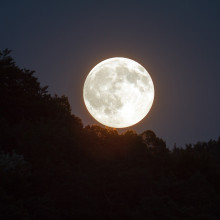
41:20 - How does the moon affect tides?
How does the moon affect tides?
Astrophysicist, Matt Middleton, gave Chris Smith a super answer to this question from Tom.
Matt - A great question. The Moon and the Earth interact through gravity and it’s what we call a ‘tidal force.’ The clues in the name it’s a tidal force, we’re talking about tides. Now because the Earth is a crust; it’s solid at least on the outside and then you’ve got all these oceans… the Moon can try and pull that crust but it’s not going to go anywhere but the oceans, on the other hand can, because it can slosh around. What you find is that there’s a bulge of water which tracks the motion of the Moon.
In a supermoon, we have the Moon being as close as possible to Earth in it’s elliptical orbit - it’s what we call perigee. A supermoon, when we see it big and bright in the sky, and on a supermoon it’s about 14% bigger than when it’s at its smallest, which is roughly the same difference between a 1p and a 2p piece. When that happens we have an alignment of the Earth, the Moon, and the Sun - it’s what we call perigee syzygy.
Chris - Can you spell that?
Matt - I can now, yes. S-y-z-y-g-y. So you can’t do that in scrabble.
Chris - Wow. That was quick.
Matt - I know, it’s remarkable isn’t it? I just have these things in my head. So when you have perigee syzygy, which should create an elf out of nowhere, then you have this supermoon. Because it’s closer to the Earth, you have a stronger tidal interaction so you have stronger tides. When the Moon is a very long way away, it’s called a mini moon. It might be a micro moon rather than a mini moon.
Chris - When I was at school, one of my colleagues got caught outside at night - it was a boarding school - and the house master said to him “why have you been sent to me with this note saying you were doing a moonie on the lawn outside the boarding house - what’s a moonie?” So the kid turned round and said “it’s seven star jumps, sir.” Got away with it - brilliant.
A quick question for you then: why are there two tides a day? Because you’ve got the Moon very close to the Earth and I can see that that’s going to pull a bulge of water on that side of the Earth facing the Moon towards the Moon. But then on the opposite side of the Earth coming round 12 hours later you’ve got a different tidal time. So why are we getting two tides a day?
Matt - Absolutely. That’s because, essentially, you’re shielding the Moon from the water using the Earth in the middle, so you’ll end up with a bulge on that side as well. And obviously these things are going round so you have two a day because they keep going round.
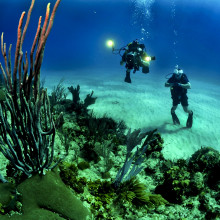
43:42 - Deep-sea diving and noisy neighbours
Deep-sea diving and noisy neighbours
Chris Smith asked marine biologist Kate Feller, from the University of Cambridge, to dive into an answer to this question from Liz. Plus, Kate told everyone in the studio about a new citizen science project which has taken to the water recently...
Kate - I wrote down the numbers because I am bad with numbers if we didn’t get that from the quiz! But 1000 metres is the official cutoff point when it’s called the ‘aphotic zone,’ so anything deeper than 1000 metres no sunlight will be coming from the surface. However, you will not be in total darkness because animals make their own light. There’s loads of bioluminescent organisms found at these kind of depths so, while the background that you’re looking at this animals at will be totally dark as far as there’s no sunlight, you will see the bioluminescence.
Chris - Matt?
Matt - I think, correct me if I’m wrong, is that connected to the idea of an optical depth down into the water? Because it’s the same principle as when you’re driving along through fog, you only ever see to what we call one optical depth, which is the point at which half of your photons get scattered. So you’re only seeing to one optical depth when you’re driving through fog and I’m guessing maybe it’s a similar thing when you have the water.
Kate - That’s one of the reasons why studying animals’ vision underwater is really great because you have this highly predicted spectrum of light from the surface to depth, based on the physics of how light interacts with water molecules and the stuff that’s dissolved in water.
Chris - So animals- fish, marine species - that live close to the surface, they’re seeing the full spectrum of light because it hasn’t been soaked up yet, but the deeper you go the less and less red light there is in the water, and once you get really, really deep there’s almost no light? So does that mean then that the animals that make light are making any colours of light or do they tend to make light of certain colours and they can see it, but the other animals can’t?
Kate - I’d say most of the bioluminescence that you have down in the open ocean at depth is going to be on the blue/green end of the spectrum. But there are a few, particularly the dragon fish…
Chris - Stomid fish?
Kate - Yeah. They actually have bioluminescent patches underneath their eyes - that are red. Because there's no red light at that kind of depth no-one can see it, basically, except these guys can.
Chris - So it’s like being spotlighted?
Kate - Yeah. They’ve got these like stealth scopes and they just snoop around in the dark.
Chris - They can use it to talk to each other and they can use it to see the things that they want to eat, but the thing that they’re after can’t see it being spotlit?
Kate - Yeah.
Chris - Isn’t that incredible.
Kate - There’s two ways you can make bioluminescence. The animal can either synthesise the enzymes and all the molecules themselves, or they can have an organ that cultures a bacteria that does it for them. Animals that live closer to the shore where the light environment, I guess, at shallower depths where you have more of those organics I mentioned earlier, the gelbstoff, they will actually have red shifted bioluminescence.
Chris - Isn’t the marine realm an amazing place. Now, there’s a really interesting story this week, Kate, for people who are keen on kayaking. You tell the story because it was a fascinating read this…
Kate - Yeah. There’s this amazing movement that’s happening right now where there’s all of this open sourced technology that’s available to just normal people who are just really keen. It’s not all isolated to people with a lot of money or who are working in labs and they’re experts.
What this research group did is they developed a data tracking system that you can mount onto a kayak. Specifically it’s what they were targeting it on, but you can also put it on a canoe, or a paddle board, or really any kind of pleasure water craft that is paddle powered. It turns information from the environment into an auditory signal or sound so you can basically play music based on changes in temperature. It will play a higher note from a digital thermometer so it converts the information from the thermometer into a digital tone that changes in its frequency depending on if it is warmer or colder, so higher temperatures, higher note; lower temperatures, lower note. You can be paddling along and go err-urr-err-urr if you’re going through different temperatures.
Chris - People go on these sorts of pursuits to get away from it all. It sounds like the reverse!
Kate - It has a very artistic element to it. If you are interested in creating auditory soundscapes and just enjoying something like that it has that kind of element to it. But what is more important is that it’s actual data that this open source thing you can build is collecting.
What they talk about that’s most important is that there aren’t a lot of very large data sets for changes in temperature or changes in the soundscapes of harder to reach waterways like estuaries, for instance, where a lot of people would be using these boats because, as you’re going, the little computer called the Raspberry Pie that’s the heart of this is uploading your deta as well as your GPS coordinates.
So it can generate these maps that go to public databases that scientists can access and so science with related to climate change and how things are changing in aquatic systems. It’s really cool and I really want to build one with my dad.
Chris - Well next time you’re on the programme Kate, you can tell us how you got on.
Kate - Okay.
Chris - But maybe wait for the weather to be nice, which might take a while in this country?
Kate - Yeah.
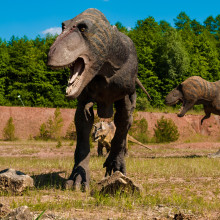
Genetics, bring back the dinosaurs!
Chris Smith asked geneticist, Patrick Short from the University of Cambridge, to engineer an answer to this question from Georgia.
Patrick - Ever since Jurassic Park came out I think this question has been of interest. What happened in that movie is they found a mosquito in amber that had bitten a dinosaur right before it was preserved, and they could recover DNA and then use that to resurrect the dinosaur. The unfortunate reality is that the half life of DNA is about 500 years and the dinosaurs became extinct 60 million years ago or so. So the likelihood of finding well preserved dinosaur DNA is almost impossible, but it’s not to say it is impossible.
However, there are scientist working on the Woolly Mammoth because it went extinct only about 4000 years ago, so they’ve been able to find plenty of good DNA in the frozen tundra. They’re editing using this CRISPR technology that we were talking about to edit the genome of an Asian Elephant in order to make it more Woolly Mammoth like as an attempt to resurrect it, so it’s pretty cool stuff, yeah.
Chris - Not a dinosaur though?
Patrick - No, not a dinosaur.
Chris - You don’t think there’s any chance? Because we had Eske Willerslev on the programme a month or so ago and he was saying he’s got the record, at the moment, for the oldest remains that he’s managed to get DNA from.
Patrick - That’s a horse, right?
Chris - Round about 700 thousand years. So you’re saying with the DNA, every 500 hundred years you get half as much as you had before. Do you mean it falls apart more?
Patrick - Yes, it falls apart. So 700,000 to 65 million is still quite a big jump, but I am an optimist for sure so I’m hoping they figure it out. They’ve got well preserved dinosaur bones but they haven’t been able to get usable DNA out of it, but it may be better in the future; this kind of technology is evolving very, very quickly.
Chris - Phillip?
Phillip - I was just going to say presumably you could go the other way? You could start with a modern lizard and kind of back evolve it.
Patrick - Turn a chicken into a raptor of some sort. Yeah, I think you’re onto something.
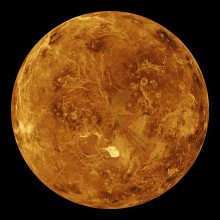
51:14 - Why does Venus spin in a different direction?
Why does Venus spin in a different direction?
Astrophysicist, Matt Middleton, had Chris Smith and everyone in the studio spinning with his answer to Connie's question, does Venus rotate the "wrong way"?
Matt - I try not to judge but you're absolutely right. Basically all the planets, the way that we view it, they all rotate counter-clockwise. If we were to stand above the solar system the Sun is spinning counter-clockwise, the planets are orbiting counter-clockwise and they're spinning counter-clockwise with two notable exceptions.
It’s not just Venus actually, Uranus is also tilted so it’s actually got its poles aligned with what we call the ecliptic, so it’s been knocked over 90 degrees roughly. Venus, on the other hand is completely upside down, the way that we see it, so it’s been flipped. There’s a few ideas, unfortunately, it’s quite unsatisfactory, there isn’t a solid answer yet, but the idea is that maybe there was some sort of interaction in the early solar system. There’s this thing called planetesimals which were flying around doing all sorts of things, interacting, bumping into stuff. It’s possible that there was some sort of collision in its lifetime that flipped it. So from Venus’s perspective everything’s normal. It’s not done anything; it’s still spinning the right way; it’s just had a bad experience; it has just had a bad day.
The other possibility, which people are investigating, is that could it have actually slowed and then started spinning in the other direction? These are still unanswered questions.
Chris - Would that be a bit like you can do the experiment with an egg. If you spin an egg, put your finger on and stop it, take your finger off, and because the innards of the egg have momentum they can make the egg spin? Is someone saying Venus could have something similar to that going on?
Matt - It’s possible. I think they’re mostly investigating the tidal interactions between the Sun and Venus because Venus has got an incredibly dense atmosphere. You're probably talking about an incredible amount of time. But interesting egg analogy, I’m sure they’ll be people listening and thinking oh, that’s my next research paper.
Chris - Kate?
Kate - What kind of experiments do you do to test these sorts of things?
Matt - Expensive ones.
Kate - Are they expensive computationally? Coming from biology I’ve no idea what I would do.
Matt - In order to get to the answer we have to understand the early time during the solar system, and that’s not an easy thing to do. There are still some rocks flying around that we can look at. There’s all these carbonaceous meteorites, all these things from very early on in the solar system, but really we need to study things like Jupiter, believe it or not, because we need to understand what it’s made of because that tells us about how the early solar system evolved. There’s some evidence to imply that Jupiter migrated from the outer solar system inwards and which would mean it has a different chemical composition to what it would have if it was born in situ. So we have to explore these things to understand how did the solar system develop. Maybe that will give us some answers, maybe it won’t. What I know is it’s not going to change the way Venus is spinning.

Is stress genetic?
Chris Smith asked geneticist, Patrick Short from the University of Cambridge, to get to the bottom of this question.
Chris - That’s got quite strong genetic underpinnings, hasn’t it, your tendency towards mental illness?
Patrick - Yeah, absolutely. Things like obsessive compulsive disorder, schizophrenia, what I study; developmental disorders, all have very strong genetic underpinnings. They’re all different and, generally, the way they’ve been studied traditionally is looking at twins. You have monozygotic twins that have the exact same DNA and they’re raised by the same family, and then dizygotic twins, they share the same DNA their siblings would have, so half but also shared by the same family. If you look at, over time, the way monozygotic twins versus dizygotic twins get disorders like these mental health issues, you can actually work out how much of it is genetic in basis and how much has to do with other effects.
The way you handle stress is almost, in part, genetic. Also things like addiction; whether we’re susceptible to become addicted to alcohol or tobacco also have genetic underpinnings. So we’re beginning to understand this and figure out how to alter it a lot better these days now that we can genome sequence hundreds and thousands of people.
Chris - Does it work that you have a gene and that causes the condition, or does the gene in some way influence your behaviour that means you’re more susceptible to becoming depressed or getting schizophrenia? Do we understand how it works yet?
Patrick - We don’t fully understand how any of it works but I think both of those can be true. For instance, there are specific molecules that affect how you actually metabolise drugs like tobacco, or even pharmaceuticals that we take. You can have a slightly different protein that means the way you break down caffeine or tobacco is different.
But you can also have changes that affect your behaviour and affect the way you interact with the substance. This is commonly discussed in obesity for instance, because you can affect the way people metabolise the food physically, or you can affect their interaction with food and whether they’re likely to continue eating when they’re no longer hungry. So both of these things actually are at play.
Chris - Phillip?
Phillip - I was just going to say how do you disentangle experimentally how much of the influence, or how much of your susceptibility to these things is environmental and how much is genetic?
Patrick - The twin studies help in part because in one case they share half their DNA and in the other case they share all their DNA, but they have the same environmental influences. If something is fully genetic then you would see that the dizygotic twins that share half their DNA will have the shared trait together half the time, whereas the full twins will have it 100% of the time. If it’s only 25% genetic then you’ll see a different relationship basically.
And then there’s also a lot of experimental techniques that you can use to introduce changes and see how they affected to try and get at this causal link. Genetics is beautiful because it doesn’t have the reverse causality problem. You are born with your genome and you can’t change it in general. Although, as we talked about earlier, you may be able to change but, in general, you can’t change it. So it’s not that your behaviour is changing your DNA, it’s much more likely that your DNA is changing your behaviour.
Chris - What percentage difference in risk do the genes that you’re studying make to someone having depression, or schizophrenia, or obsessive compulsive disorder? What’s the loading or the contribution?
Patrick - The very rare and severe disorders that I study, it’s almost like night and day. If you have a mutation in the gene then you're almost 100% chance of getting this disorder and it’s going to be very severe, but I study very, very severe disorders. On the flip side, if you think about autism, or even schizophrenia, OCD, there are hundreds or thousands of independent, very small changes that actually just contribute a 2% risk or a 3% elevated risk over what we’d call the baseline. Most diseases are operating on this very complex genetic architecture.
Chris - The end point is becoming depressed or suffering OCD, but then there may be many different genes, thousands of genes that could, potentially, make a tiny contribution or tip the balance a little bit. So it’s not a given if you have this gene you’re going to get this condition, it’ll just increase your likelihood of going down that pathway?
Patrick - That’s exactly right.










Comments
Add a comment